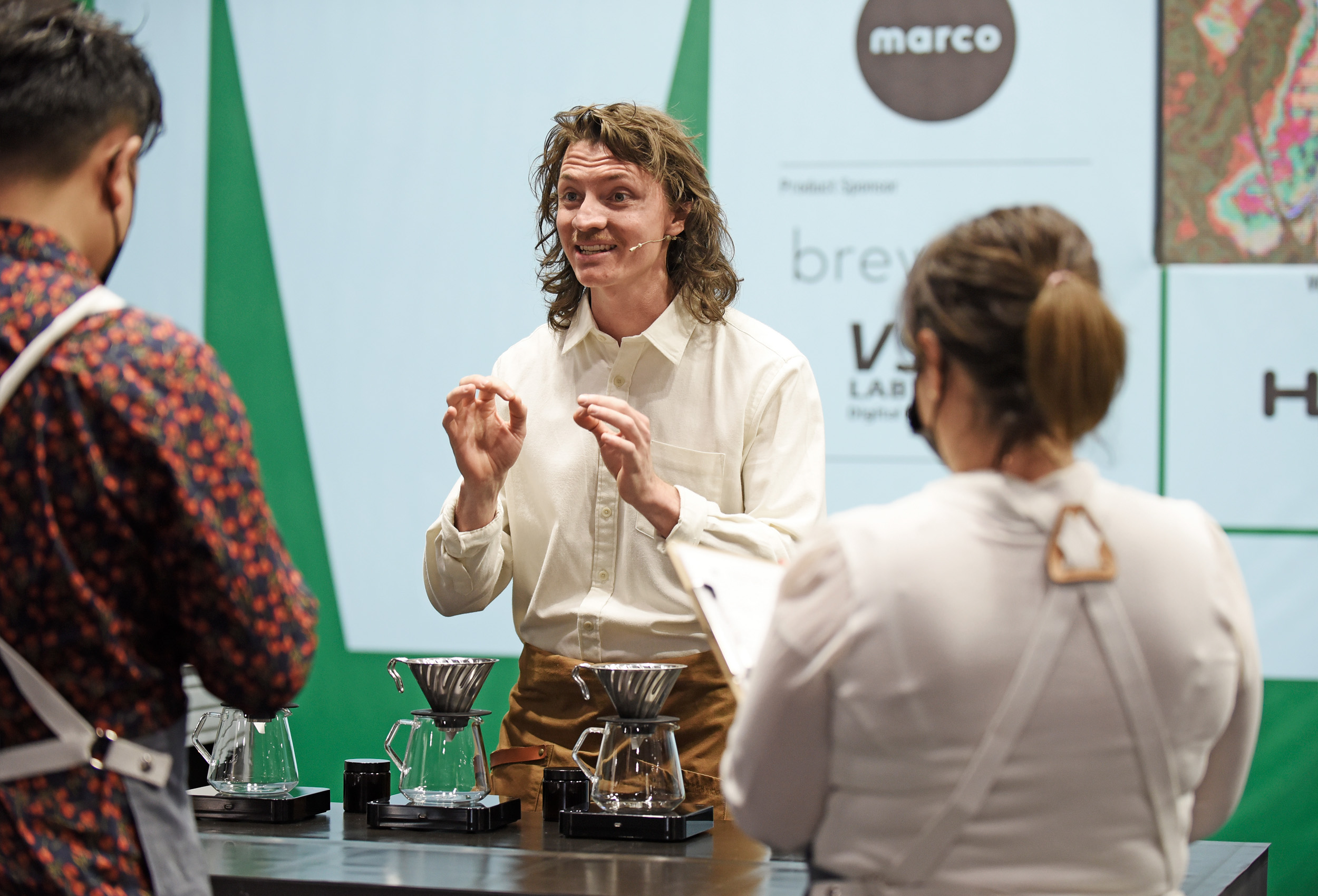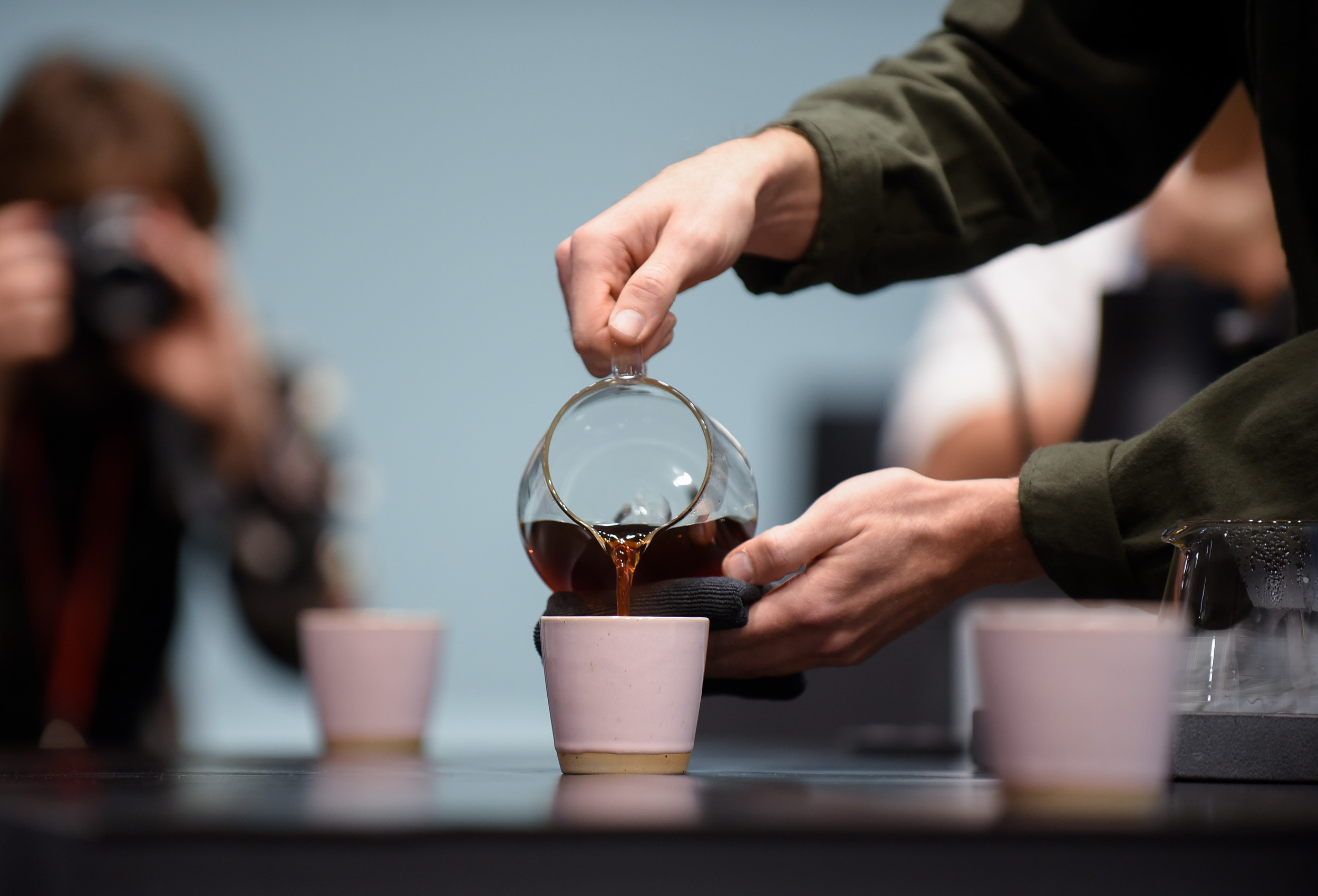The 5-Pour Method
This week our Dean of Studies, Jem Challender, interviewed the 2021 World Brewers Cup (WBrC) Champion, Matt Winton, to learn more about his 5-pour method and his approach to blooming. Matt won the Swedish Barista Championship in 2018 and 2019. Prior to becoming a barista, Matt worked as an aerospace engineer.
In the open service round of the WBrC, Matt blended two species of coffee together in the Coffea eugenioides and arabica, a first for a barista competition event. While his recipe was highly effective in the competition, his technique was quite different to most commonly accepted brew methods and different to what we generally recommend at Barista Hustle — because his method of blooming did not involve any manual agitation. As Matt explains to us in this interview, the turbulence created by his kettle stream can be enough to produce high and even extraction yields. Matt also walks us through how he uses his pouring kettle to achieve a level coffee bed without needing to spin the coffee bed after each pour.
Pictures kindly supplied by CoffeeShots
We also get some insight into Matt’s meticulous approach to the challenging compulsory service round of the WBrC, in which all the competitors have to brew the same coffee. Competitors are not provided with any information about the compulsory coffee, but there are very few restrictions on the brew method a barista uses, so long as they do not use more than two appliances.
Enjoy this interview, which describes how to achieve extraordinary results without stirring your brew, from the current World Brewers Champion.
Interview with World Brewers Cup Champion, Matt Winton
Jem Challender: Can you tell us a bit about your approach to blooming and agitating brews and what alterations you might make (if any) between a competition setting and a café setting?
Matt Winton: I think the biggest reason not to stir is the time it takes, the inconsistency, and the workflow on stage.
I’ve never wanted to stir for a competition. The last time I remember someone doing so was in 2017 with Constantin, the German competitor (I could be wrong and someone has done it since), but it’s just not practical for a competition.
My personal view is that agitation is necessary, but if I do a two-pour brew, with a bloom and just one pour after — then I want to stir. That’s because I don’t have enough chances of pouring water to agitate and extract enough, so I’ll end up with an understrength brew. But I can get around that by doing multiple pours and making sure I pour a little more aggressively. At the WBrC, I was almost maxing out the flow rate of my pouring kettle with each pour. Without that I wouldn’t have gotten the desired strength. I also did a centre pour to ‘flood the bed’ and then circles to ‘agitate/hit the rest of the coffee’ and then finished centre just for control and accuracy.
JC: What kind of grind profile did you go with for the competition?
MW: I ground quite coarse — around setting 3.6 on the Kinu [hand grinder] and around 30 clicks on the Comandante. The reason for this was that I could do the five pours without getting bitterness or dryness. We didn’t have the same expression from the blend with four pours, so it had to be five. Three was way off too 😂.
That being said, the eugenioides was the main component of my blend, and it was super soluble. In the end, we fixed the grind size coarse and only adjusted it to get the strength we were after. In fact, we only adjusted it once on finals day to go finer to account for the coffees ageing one extra day (they were five days from roast on the final day).
JC: How much did you and your team play with blooming as a variable when designing your recipe for competition?
MW: Bloom was a variable we played with a lot. For this brew it had to be a 50-g bloom, lasting for 35 seconds. We tried 30 seconds and that was okay if the coffees were aged. We tried up to 45 sec, which was okay when the coffees were even more fresh, but as they aged it turned a touch cacao-like in the finish. Blooming for 35 seconds meant it was jasmineAct and guava all the way. Even after three hours of cooling — it was still delicious.
The first pour was 50-g as a bloom; then the next pour was 70-g; then each pour after that was 60-g. We had some problems with dryness during practice the week before, so we really focused on removing that — which we managed with a mix of roast, water, and brewing.
In the brewing we made sure not to let the bed run dry at all (except for the bloom). I was pouring almost as fast as I could go to get back to the first brew of the three without it being dried out. If I let it drip out too much, we had the potential for some dryness to sink in.
JC: What was the idea behind using two pouring kettles with different temperatures?
MW: The idea behind having a second pouring kettle at a lower temperature started as a way to mimic the drop in temp that fell naturally. But then we moved it down a couple of degrees and liked the juiciness it gave, but didn’t go too far because we didn’t want to introduce any sourness. The catucai component was roasted very lightly in order to bring a lot of vibrancy, but the higher bean density meant there was the potential for things to go sideways sometimes.
JC: I remember tasting the USBrC Champion Sarah Anderson’s Coffea eugenioides which she took to the finals of the 2015 WBrC. It was amazingly sweet and similar to drinking sencha, with almost no acidity. But this is the first time I’m aware of a competitor blending Coffea eugenioides and arabica together. How much do you think it was the blend of these two species that led you to the 5-pour approach?
MW: That’s a good question — I was training with a flat-bed brewer up until I brought the eugenioides into the mix. I did one brew on a flat-bed, and it was awwwwful. It just really didn’t work at all on a flat-bed — got savoury and muddy out of nowhere. Then I switched to a cone brewer, and it brought out clarity again! I was also training with a Kono, an Origami, and a glass V60, but the metal just really gave a clarity and brightness to the expression that we didn’t find elsewhere!
For flat-bed, I really learned everything from Patrik Rolf at April. His understanding of the variables with his brewer are fantastic. He does mostly no real bloom on his brewer, to great effect. I found that the way of pouring mattered very much on the flat-bed; especially when using just two pours (if it wasn’t aggressive enough, or was too fast for a given grind setting and pouring pattern, for example).
JC: Did you use the 5-pour approach in the Compulsory Service, too?
MW: For the Compulsory Service, I had a pretty solid approach. I felt like I was ready for any sort of coffee that came. I had four brewing techniques I’d trained a lot to get used to. I had a standard V60 drip method; a full immersion method on a Bonavita immersion brewer; a concentrate immersion and drip method on the Bonavita; and an AeroPress compulsory method.
When I tried the coffee first, it was very flat and dry. I knew I wanted to remove the dryness and give the coffee vibrancy and life, targeting the body, balance, and in turn the acidity part of the scoresheet. So I ended up going straight for concentrate methods with a very low temperature (81 degrees C) and very hot bypass (100 degrees C) and then diluted to strength.
If I were to do the Compulsory with a drip method, then I’d probably try the 5-pour first, as the coffee should be good enough to brew properly. But it’s all about the variables and the time during the Compulsory Service — not the easiest thing!

